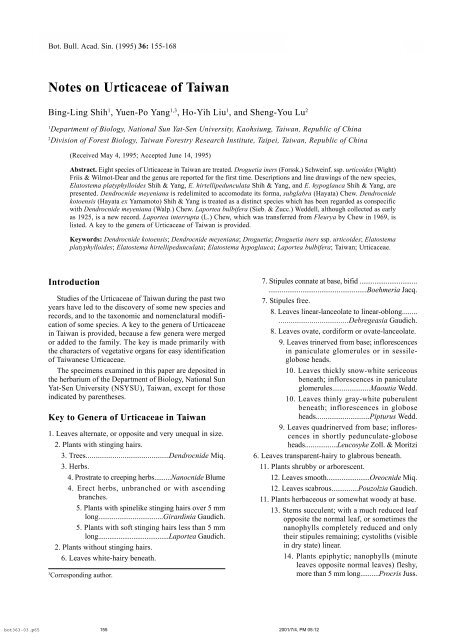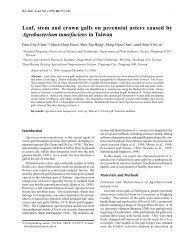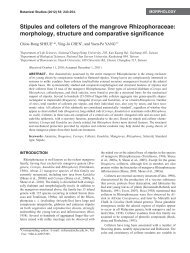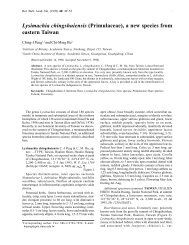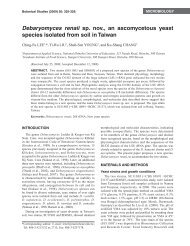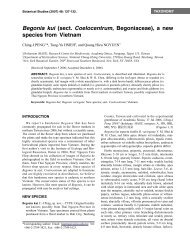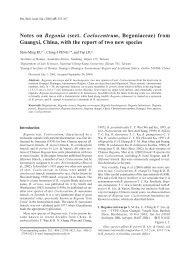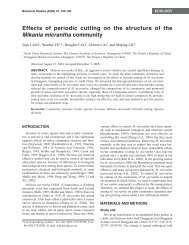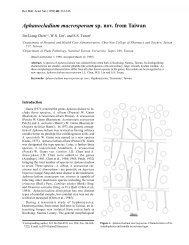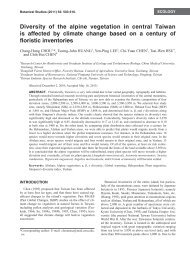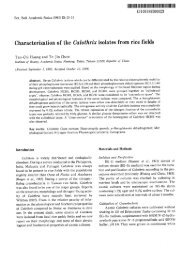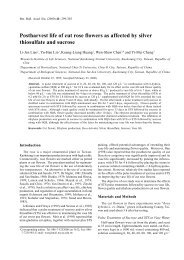Notes on Urticaceae of Taiwan - Academia Sinica
Notes on Urticaceae of Taiwan - Academia Sinica
Notes on Urticaceae of Taiwan - Academia Sinica
You also want an ePaper? Increase the reach of your titles
YUMPU automatically turns print PDFs into web optimized ePapers that Google loves.
Shih Bot. Bull. et al. Acad. — <str<strong>on</strong>g>Notes</str<strong>on</strong>g> Sin. <strong>on</strong> (1995) <strong>Urticaceae</strong> 36: 155-168 <strong>of</strong> <strong>Taiwan</strong><br />
<str<strong>on</strong>g>Notes</str<strong>on</strong>g> <strong>on</strong> <strong>Urticaceae</strong> <strong>of</strong> <strong>Taiwan</strong><br />
Bing-Ling Shih 1 , Yuen-Po Yang 1,3 , Ho-Yih Liu 1 , and Sheng-You Lu 2<br />
1 Department <strong>of</strong> Biology, Nati<strong>on</strong>al Sun Yat-Sen University, Kaohsiung, <strong>Taiwan</strong>, Republic <strong>of</strong> China<br />
2 Divisi<strong>on</strong> <strong>of</strong> Forest Biology, <strong>Taiwan</strong> Forestry Research Institute, Taipei, <strong>Taiwan</strong>, Republic <strong>of</strong> China<br />
(Received May 4, 1995; Accepted June 14, 1995)<br />
Abstract. Eight species <strong>of</strong> <strong>Urticaceae</strong> in <strong>Taiwan</strong> are treated. Droguetia iners (Forssk.) Schweinf. ssp. urticoides (Wight)<br />
Friis & Wilmot-Dear and the genus are reported for the first time. Descripti<strong>on</strong>s and line drawings <strong>of</strong> the new species,<br />
Elatostema platyphylloides Shih & Yang, E. hirtellipedunculata Shih & Yang, and E. hypoglauca Shih & Yang, are<br />
presented. Dendrocnide meyeniana is redelimited to accomodate its forma, subglabra (Hayata) Chew. Dendrocnide<br />
kotoensis (Hayata ex Yamamoto) Shih & Yang is treated as a distinct species which has been regarded as c<strong>on</strong>specific<br />
with Dendrocnide meyeniana (Walp.) Chew. Laportea bulbifera (Sieb. & Zucc.) Weddell, although collected as early<br />
as 1925, is a new record. Laportea interrupta (L.) Chew, which was transferred from Fleurya by Chew in 1969, is<br />
listed. A key to the genera <strong>of</strong> <strong>Urticaceae</strong> <strong>of</strong> <strong>Taiwan</strong> is provided.<br />
Keywords: Dendrocnide kotoensis; Dendrocnide meyeniana; Droguetia; Droguetia iners ssp. urticoides; Elatostema<br />
platyphylloides; Elatostema hirtellipedunculata; Elatostema hypoglauca; Laportea bulbifera; <strong>Taiwan</strong>; <strong>Urticaceae</strong>.<br />
Introducti<strong>on</strong><br />
Studies <strong>of</strong> the <strong>Urticaceae</strong> <strong>of</strong> <strong>Taiwan</strong> during the past two<br />
years have led to the discovery <strong>of</strong> some new species and<br />
records, and to the tax<strong>on</strong>omic and nomenclatural modificati<strong>on</strong><br />
<strong>of</strong> some species. A key to the genera <strong>of</strong> <strong>Urticaceae</strong><br />
in <strong>Taiwan</strong> is provided, because a few genera were merged<br />
or added to the family. The key is made primarily with<br />
the characters <strong>of</strong> vegetative organs for easy identificati<strong>on</strong><br />
<strong>of</strong> <strong>Taiwan</strong>ese <strong>Urticaceae</strong>.<br />
The specimens examined in this paper are deposited in<br />
the herbarium <strong>of</strong> the Department <strong>of</strong> Biology, Nati<strong>on</strong>al Sun<br />
Yat-Sen University (NSYSU), <strong>Taiwan</strong>, except for those<br />
indicated by parentheses.<br />
Key to Genera <strong>of</strong> <strong>Urticaceae</strong> in <strong>Taiwan</strong><br />
1. Leaves alternate, or opposite and very unequal in size.<br />
2. Plants with stinging hairs.<br />
3. Trees...........................................Dendrocnide Miq.<br />
3. Herbs.<br />
4. Prostrate to creeping herbs.........Nanocnide Blume<br />
4. Erect herbs, unbranched or with ascending<br />
branches.<br />
5. Plants with spinelike stinging hairs over 5 mm<br />
l<strong>on</strong>g..................................Girardinia Gaudich.<br />
5. Plants with s<strong>of</strong>t stinging hairs less than 5 mm<br />
l<strong>on</strong>g......................................Laportea Gaudich.<br />
2. Plants without stinging hairs.<br />
6. Leaves white-hairy beneath.<br />
3 Corresp<strong>on</strong>ding author.<br />
bot363-03.p65 155<br />
2001/7/4, PM 05:12<br />
155<br />
7. Stipules c<strong>on</strong>nate at base, bifid ...............................<br />
....................................................Boehmeria Jacq.<br />
7. Stipules free.<br />
8. Leaves linear-lanceolate to linear-obl<strong>on</strong>g........<br />
....................................Debregeasia Gaudich.<br />
8. Leaves ovate, cordiform or ovate-lanceolate.<br />
9. Leaves trinerved from base; inflorescences<br />
in paniculate glomerules or in sessileglobose<br />
heads.<br />
10. Leaves thickly snow-white sericeous<br />
beneath; inflorescences in paniculate<br />
glomerules....................Maoutia Wedd.<br />
10. Leaves thinly gray-white puberulent<br />
beneath; inflorescences in globose<br />
heads............................Pipturus Wedd.<br />
9. Leaves quadrinerved from base; inflorescences<br />
in shortly pedunculate-globose<br />
heads.................Leucosyke Zoll. & Moritzi<br />
6. Leaves transparent-hairy to glabrous beneath.<br />
11. Plants shrubby or arborescent.<br />
12. Leaves smooth.......................Oreocnide Miq.<br />
12. Leaves scabrous..............Pouzolzia Gaudich.<br />
11. Plants herbaceous or somewhat woody at base.<br />
13. Stems succulent; with a much reduced leaf<br />
opposite the normal leaf, or sometimes the<br />
nanophylls completely reduced and <strong>on</strong>ly<br />
their stipules remaining; cystoliths (visible<br />
in dry state) linear.<br />
14. Plants epiphytic; nanophylls (minute<br />
leaves opposite normal leaves) fleshy,<br />
more than 5 mm l<strong>on</strong>g..........Procris Juss.
156<br />
14. Plants terrestrial; nanophylls membranous<br />
and less than 4 mm l<strong>on</strong>g if<br />
present.<br />
15. Inflorescence bracts somewhat<br />
c<strong>on</strong>nate into an involucre; staminate<br />
inflorescence 1–2-flowered, or<br />
many-flowered heads......................<br />
.......Elatostema Forster & Forster f.<br />
15. Inflorescence bracts free; staminate<br />
inflorescences many-flowered<br />
cymes.................. Pelli<strong>on</strong>ia Gaudich.<br />
13. Stems not succulent; without reduced leaves<br />
(nanophylls) or their stipules opposite<br />
normal leaves; cystoliths dot-like..................<br />
........................................Pouzolzia Gaudich.<br />
1. Leaves opposite, at least at lower part <strong>of</strong> plant.<br />
16. Plants with stinging hairs............................Urtica L.<br />
16. Plants without stinging hairs.<br />
17. Plants almost woody throughout.<br />
18. Inflorescence an axillary, globose, sessile<br />
head ................................Cypholophus Wedd.<br />
18. Inflorescence an axillary, spicate, cymose or<br />
paniculate glomerule ........... Boehmeria Jacq.<br />
17. Plants herbaceous, or somewhat woody at base.<br />
19. Plants succulent; stipules 2, c<strong>on</strong>nate at base<br />
or close to each other at base, intrapetiolar;<br />
cystoliths linear.<br />
20. Inflorescence a pedunculate discoid head<br />
.........................................Lecanthus Wedd.<br />
20. Inflorescence various, but not a discoid<br />
head..................................... Pilea Lindley<br />
19. Plants not succulent; stipules 2 or 4, free, not<br />
close to each other, lateral or intrapetiolar;<br />
cystoliths dot-like.<br />
21. Leaves serrate.<br />
22. Inflorescences a group <strong>of</strong> 2 or more<br />
flowers <strong>of</strong> 1 or both sexes (<strong>on</strong>ly <strong>on</strong>e<br />
female flower in some axils), enclosed<br />
by an involucre <strong>of</strong> fused bracts; male<br />
flower with 1 stamen............................<br />
.............................Droguetia Gaudich.<br />
22. Inflorescences a group <strong>of</strong> at least<br />
several flowers <strong>of</strong> 1 or both sexes, not<br />
surrounded by a comm<strong>on</strong> involucre <strong>of</strong><br />
fused bracts; male flower with 4–5<br />
stamens.<br />
23. Plants decumbent; stigma penicillate<br />
when blooming, becoming<br />
ovoid when fruiting.......................<br />
......................Chamabainia Wight<br />
23. Plants erect or ascending; stigma<br />
linear ................. Boehmeria Jacq.<br />
21. Leaves entire ..............G<strong>on</strong>ostegia Turcz.<br />
Botanical Bulletin <strong>of</strong> <strong>Academia</strong> <strong>Sinica</strong>, Vol. 36, 1995<br />
1. DROGUETIA Gaudich.<br />
Annual or perennial, m<strong>on</strong>oecious herbs or subshrubs<br />
with erect, ascending, creeping, or prostrate stems. Leaves<br />
opposite or alternate, petiolate; cystoliths punctiform;<br />
stipules lateral, free. Flowers sessile or subsessile, surrounded<br />
by a tubular or campanulate involucre, arranged<br />
singly or several together in axils or arranged al<strong>on</strong>g l<strong>on</strong>g,<br />
leafless axis to form terminal spike. Male flowers somewhat<br />
navicular; perianth c<strong>on</strong>nate at base when blooming,<br />
cylindrical to c<strong>on</strong>ical, splitting al<strong>on</strong>g <strong>on</strong>e side, the upper<br />
lobe with a somewhat erect tip; stamens 1; rudimentary<br />
ovary absent. Female flowers without perianth; stigma linear.<br />
Achenes enclosed in a persistent involucre.<br />
About 7 species, distributed in tropical and southern<br />
Africa, Madagascar, Mascarenes, southern India, China,<br />
and Java. One species in <strong>Taiwan</strong>, at medium altitudes in<br />
the central and southern parts.<br />
Droguetia iners (Forssk.) Schweinf. ssp. urticoides<br />
(Wight) Friis & Wilmot-Dear in Friis, Immelman &<br />
Wilmot-Dear, Nordic J. Bot. 7: 126. 1987; Friis &<br />
Wilmot-Dear, Nordic J. Bot. 8: 41. 1988.<br />
Figure 1<br />
Forsskaolea (“Forskohlea”) urticoides Wight, Ic. Pl. Ind.<br />
Or., 6: Tab. 1982. 1853.<br />
M<strong>on</strong>oecious, perennial, ascending or creeping herbs;<br />
stems brownish, hirsute throughout, sometimes bearing<br />
adventitious roots at nodes, subquadrate, sulcate at each<br />
side. Leaves opposite; petioles 0.5–3 cm l<strong>on</strong>g, semiterete,<br />
sulcate at adaxial side; lamina trinerved from base with<br />
1–2 upper pairs <strong>of</strong> veins, membranous, hirsute <strong>on</strong> upper<br />
surface and lower veins, ovate, (1–) 1.5–3.5 (–4) cm l<strong>on</strong>g,<br />
(0.5–) 1–2.5 (–3) cm broad, obtuse to rounded at base,<br />
entire in lower part <strong>of</strong> margins, serrate and ciliate in upper<br />
part <strong>of</strong> margins, acuminate to caudate at apex; stipules 4,<br />
lateral, free, hirsute <strong>on</strong> abaxial veins, entire, ciliate, ovate<br />
to ovate-lanceolate, 2–5 mm l<strong>on</strong>g, 1–3 mm across.<br />
Inflorescences several aggregated; involucres tubulate or<br />
campanulate, 5-toothed, ciliate, tomentose and hirsute<br />
outside. Male flowers navicular, ca. 2 mm l<strong>on</strong>g, splitting<br />
<strong>on</strong>e side, unequally 3-toothed, villous outside; stamen 1,<br />
the filament robust, with many transverse vermicular<br />
furrows at adaxial side. Female flowers with ovary smooth;<br />
stigma filiform-ligulate, puberulent at <strong>on</strong>e side. Achenes<br />
ovoid, 1–1.5 mm l<strong>on</strong>g, laterally compressed, angled.<br />
Specimens examined. TAICHUNG HSIEN: Piluchi,<br />
Shih 3001. NANTOU HSIEN: Loloku-Kuankao, Huang,<br />
Yang & Hsieh 5260 (TAI). CHIAYI HSIEN: Alisan, Chang<br />
17227 (PPI). KAOHSIUNG HSIEN: Southern Cross-<br />
Island Hwy ("South-Cross-High-Way"), Shih 3336.<br />
Distributi<strong>on</strong>. Southern India, Java, and China. <strong>Taiwan</strong>,<br />
at medium altitudes in the central and southern parts.<br />
<str<strong>on</strong>g>Notes</str<strong>on</strong>g>. This is the first record from <strong>Taiwan</strong> <strong>of</strong> this genus<br />
and its subspecies. Specimens <strong>of</strong> the subspecies have<br />
been collected <strong>on</strong> <strong>Taiwan</strong> since 1985. They were previously<br />
misidentified as Chamabainia cuspidata Wight be-<br />
bot363-03.p65 156<br />
2001/7/4, PM 05:12
Shih et al. — <str<strong>on</strong>g>Notes</str<strong>on</strong>g> <strong>on</strong> <strong>Urticaceae</strong> <strong>of</strong> <strong>Taiwan</strong><br />
Figure 1. Droguetia iners (Forssk.) Schweinf. ssp. urticoides (Wight) Friis & Wilmot-Dear. A, Habit. B, Porti<strong>on</strong> <strong>of</strong> leaf (abaxial<br />
view). C, Stipule (abaxial view). D, Inflorescence (a female flower and some male flowers). E, Male flower. F, Inflorescence<br />
(enclosing <strong>on</strong>e female flower <strong>on</strong>ly). G, Achene with persistent, sublinear stigma. All from Shih 3001.<br />
bot363-03.p65 157<br />
2001/7/4, PM 05:13<br />
157
158<br />
cause the two taxa are very similar in vegetative parts. The<br />
subspecies can be distinguished from C. cuspidata because<br />
it has <strong>on</strong>e stamen enclosed in the navicular- or<br />
c<strong>on</strong>ical-shaped sepals <strong>of</strong> male flowers, c<strong>on</strong>nate involucres<br />
<strong>of</strong> inflorescences, and subquadrate stems.<br />
Friis and Wilmot-Dear (1988) found many collecti<strong>on</strong>s<br />
<strong>of</strong> the subspecies am<strong>on</strong>g herbarium material collected from<br />
southern India and the mountains <strong>of</strong> Java, where they were<br />
previously identified as Chamabainia. The extensi<strong>on</strong> <strong>of</strong><br />
Droguetia to <strong>Taiwan</strong> indicates that it should be looked for<br />
elsewhere in the mountains <strong>of</strong> SE Asia and Ind<strong>on</strong>esia.<br />
2. ELATOSTEMA Forster & Forster f.<br />
M<strong>on</strong>oecious or dioecious herbs; stems mostly succulent,<br />
herbaceous, rarely woody at base, simple to many<br />
branched. Leaves alternate, with or without reduced leaves<br />
(namely nanophylls) opposite normal <strong>on</strong>es, sessile to short<br />
petiolate, stipulate; lamina somewhat flush with the stem,<br />
very unequal-sided at base, the narrow side facing the<br />
stem, mostly chartaceous, rarely subcoriaceous to coriaceous,<br />
mostly with somewhat-dense linear cystoliths <strong>on</strong><br />
both sides or mostly <strong>on</strong> adaxial side, rarely without cystolith,<br />
trinerved to triplinerved or penninerved, coarsely<br />
serrate to nearly entire; stipules intrapetiolar, two at a node,<br />
the stipule <strong>of</strong> the reduced leaf opposite that <strong>of</strong> the normal<br />
leaf, usually caducous, rarely deciduous or persistent. Inflorescences<br />
mostly many-flowered discoid heads, usually<br />
with a well-developed receptacle, rarely 1–3-flowered; the<br />
heads usually two-valved, each valve including several<br />
glomerules that c<strong>on</strong>sist <strong>of</strong> several flowers and are subtended<br />
by a few large bracteoles; flowers sessile to l<strong>on</strong>gpediceled,<br />
mostly subtended by small bracteoles. Male<br />
flowers with (3–) 4–5 sepals; sepals c<strong>on</strong>nate at base, the<br />
segments slightly imbricate, usually corniculate or shortly<br />
horned below the apex; stamens (3–) 4–5; rudimentary<br />
ovary small. Female flowers with 3–5 sepals or nearly<br />
completely reduced; staminodes small, 3–5, scale-like,<br />
usually very small when blooming, developing larger during<br />
fruiting, rarely absent; ovary straight. Achenes circular<br />
in cross secti<strong>on</strong>s, mostly with l<strong>on</strong>gitudinal ribs, rarely<br />
smooth, usually dispersed by reflexing staminodes.<br />
About 350 species (Wang, 1980) in the world. About<br />
15 species found in <strong>Taiwan</strong>, growing in moist forest floors<br />
or al<strong>on</strong>g ravines from low to high altitudes.<br />
Elatostema platyphylloides Shih & Yang, sp. nov.<br />
Figure 2<br />
Species nova affinis Elatostemati platyphyllo Wedd.,<br />
sed differt stipulis subtus hirsutis, inflorescentiis 1 (–2) nec<br />
2–3 ad nodum, masculus inflorescentiis majoribus, usque<br />
ad 3 cm nec 1 cm.—TYPE: <strong>Taiwan</strong>. Taitung Hsien: Chipen<br />
logging trail, near a small waterfall, Shih 2598 (holotype:<br />
NSYSU; isotype: HAST, TAI, TAIF).<br />
Suffrutex, m<strong>on</strong>oica vel dioica. Caules usque ad 1.5 m<br />
alt. Folia sessilia vel brevissime petiolata; laminae<br />
chartaceae, plus minusve hirsutae, ellipticae vel obl<strong>on</strong>gae,<br />
10–25 cm l<strong>on</strong>gae, 4–7.5 cm latae; stipulae caducae,<br />
Botanical Bulletin <strong>of</strong> <strong>Academia</strong> <strong>Sinica</strong>, Vol. 36, 1995<br />
ciliatae, viridulae, brunneomaculatae, lanceolatae,<br />
cymbiformae, 1.5–2.5 cm l<strong>on</strong>gae, 3–5.5 mm latae.<br />
Inflorescentiae masculinae 1 (–2) ad nodum i.e.<br />
singulariter axillares, pedunculatae; receptaculum<br />
ellipsoideum, usque ad 3 cm l<strong>on</strong>gae, 2.5 cm latae; bracteae<br />
omnino c<strong>on</strong>natae. Inflorescentiae femineae singulariter<br />
axillares, sessiles vel subsessiles, usque ad 7 mm l<strong>on</strong>gae<br />
et latae.<br />
M<strong>on</strong>oecious or dioecious perennial herbs; stems somewhat<br />
woody at base, branched, somewhat hirsute at nascent<br />
parts, glabrescent, green, slightly geniculate,<br />
distinctly striated in specimens, up to 1.5 m high, 1 cm<br />
thick. Leaves alternate, sessile to short-petiolate, distichous;<br />
lamina chartaceous, somewhat hirsute, with very<br />
dense, 0.3–0.4 mm-l<strong>on</strong>g cystoliths <strong>on</strong> upper surface and<br />
mostly al<strong>on</strong>g veins <strong>on</strong> lower surface, dark green to green<br />
<strong>on</strong> adaxial side, pale green to light green <strong>on</strong> abaxial side,<br />
narrowly elliptic to obl<strong>on</strong>g, (5–) 10–25 (–30) cm l<strong>on</strong>g, (2–)<br />
4–7.5 (–8.5) cm wide, the base <strong>of</strong> the wide side<br />
semi-sagittate with an earlike limb that crosses the petiole<br />
to the opposite side, the margins ciliate and serrate to<br />
serrulate, the apex caudate, ciliate and densely serrulate,<br />
the semi-triple-nerves prominent beneath, the sec<strong>on</strong>dary<br />
veins 4–6 pairs; petioles 0–5 mm l<strong>on</strong>g; stipules 2, opposite,<br />
caducous, ciliate, glabrous <strong>on</strong> adaxial sides, hirsute<br />
<strong>on</strong> abaxial veins, greenish with minute brown spots,<br />
lanceolate-cymbiform, 1.5–2.5 (–3) cm l<strong>on</strong>g, 3–5.5 mm<br />
wide. Inflorescences 1–2 at a node, greenish, somewhat<br />
minutely puberulent outside, discoid, the male <strong>on</strong>es with<br />
two ellipsoidal parts, 1.5–3 × 1–2.5 cm in diameter, the<br />
peduncles glabrous, 3–18 mm l<strong>on</strong>g, the female <strong>on</strong>es<br />
usually in a butterfly-like outline, up to 7 × 6 mm in size,<br />
sessile or subsessile; bracts somewhat minutely puberulent,<br />
completely c<strong>on</strong>nate into an unlobed, narrowly obl<strong>on</strong>g<br />
to obl<strong>on</strong>g involucre, up to 3 cm l<strong>on</strong>g, 1 cm wide in male<br />
inflorescences, up to 7 mm l<strong>on</strong>g, 2 mm wide in female<br />
inflorescences. Male flowers pedicellate, subtended by a<br />
bracteole; bracteoles semi-transparent, with minute linear<br />
cystoliths paralleled with the midvein, cymbiform, ca. 5<br />
mm l<strong>on</strong>g, the apex ciliate, truncate or mucr<strong>on</strong>ate, the margins<br />
entire, minutely hirsute <strong>on</strong> <strong>on</strong>e-third <strong>of</strong> the abaxial<br />
veins; sepals 4, c<strong>on</strong>nate at base, semi-transparent, somewhat<br />
puberulent and minutely ciliate near apex, somewhat<br />
corniculate, cymbiform, ca. 2.3 mm l<strong>on</strong>g in blooming<br />
flowers, acute at apex; pedicels sparsely puberulent. Female<br />
flowers pedicellate, subtended by a bracteole; bracteoles<br />
semi-transparent, narrowly obl<strong>on</strong>g, ca. 0.9 mm l<strong>on</strong>g,<br />
0.3 mm wide when blooming, the upper margins and apex<br />
fimbriate, the lower margins entire, the abaxial veins puberulent<br />
subterminally; sepals 3, free, slightly unequal,<br />
narrowly triangular, ca. 0.1–0.3 mm l<strong>on</strong>g; staminodes 4,<br />
minute, enlarged when fruiting; stigma penicillate; ovary<br />
glabrous, ellipsoidal. Achenes ellipsoidal.<br />
Additi<strong>on</strong>al specimens examined. TAIPEI HSIEN:<br />
Yin-ho-tung, Wang 2745 (TAI). ILAN HSIEN: Tu-chian,<br />
Suzuki 3734 (TAI). HSINCHU HSIEN: Wuchihshan, Liau<br />
404 (TAI). TAICHUNG HSIEN: Maopu-Chinghu, Yang<br />
1323 (TAI). NANTOU HSIEN: Chitou, Ou & Kao 9126<br />
bot363-03.p65 158<br />
2001/7/4, PM 05:13
Shih et al. — <str<strong>on</strong>g>Notes</str<strong>on</strong>g> <strong>on</strong> <strong>Urticaceae</strong> <strong>of</strong> <strong>Taiwan</strong><br />
Figure 2. Elatostema platyphylloides Shih & Yang. A, Flowering branch with male inflorescences. B, Leaf (abaxial view). C, Male<br />
inflorescence (ventral view). D, Male flower with a bracteole. E, Female flower with a bracteole. F, Bracteole <strong>of</strong> a female flower<br />
(abaxial view). All from Shih 2598.<br />
bot363-03.p65 159<br />
2001/7/4, PM 05:13<br />
159
160<br />
(TAI). CHIAYI HSIEN: Fan-lu Hsiang, Alisan-Highway,<br />
Shih 2948; The Third Highway (at 353.3 km), Shih 2727.<br />
KAOHSIUNG HSIEN: Shan-ping, 1995, Lin s. n.<br />
TAITUNG HSIEN: Chipen Logging Trail, Lichai Logging<br />
Trail, Shih 3366; Du-two-shan, Shih 2738. HUALIEN<br />
HSIEN: Tienhsiang, Shimizu & Kao 10613 (TAI).<br />
Distributi<strong>on</strong>. Endemic; throughout <strong>Taiwan</strong> from low to<br />
medium altitude, except the Hengchun Peninsula. Grows<br />
mostly al<strong>on</strong>g streams and ravines, and <strong>on</strong> moist forest<br />
floors.<br />
<str<strong>on</strong>g>Notes</str<strong>on</strong>g>. This is a widely distributed species in <strong>Taiwan</strong>.<br />
It has for a l<strong>on</strong>g time been err<strong>on</strong>eously recognized as<br />
Elatostema edule C. Robins<strong>on</strong>. Elatostema platyphylloides<br />
is distinctly different from Elatostema edule in having hairs<br />
almost throughout the plant, serrate leaf apices, and<br />
chartaceous leaves when fresh. In c<strong>on</strong>trast, the plants <strong>of</strong><br />
Elatostema edule are glabrous and have leaves fleshy when<br />
fresh and with a single, entire, l<strong>on</strong>g-tooth apex. Elatostema<br />
platyphylloides was also mis-identified as Elatostema<br />
platyphyllum Wedd. Elatostema platyphylloides can be<br />
distinguished from Elatostema platyphyllum by having<br />
hirsute hairs <strong>on</strong> the abaxial sides <strong>of</strong> stipules, and 1–2<br />
inflorescences at a node.<br />
With the separati<strong>on</strong> <strong>of</strong> this new species, Elatostema<br />
edule is now found <strong>on</strong>ly in a strict distributi<strong>on</strong>al range from<br />
the Lutao and Lanyu islets <strong>of</strong> <strong>Taiwan</strong> to the Batan islands<br />
<strong>of</strong> the Philippines (Robins<strong>on</strong>, 1911). The first author has<br />
never seen the species <strong>on</strong> the main island <strong>of</strong> <strong>Taiwan</strong>—especially<br />
surprising in Hualien, Taitung, and the Hengchun<br />
Peninsula, which are close to Lutao and Lanyu.<br />
Dr. Wilmot-Dear menti<strong>on</strong>ed that Kew has 3 specimens<br />
<strong>of</strong> Elatostema edule from Hainan, which appear to fit the<br />
descripti<strong>on</strong> <strong>of</strong> this new species. Therefore, it probably occurs<br />
in Hainan as well.<br />
Elatostema hirtellipedunculata Shih & Yang, sp. nov.<br />
Figure 3<br />
Species nova affinis Elatostemati herbaceifolio Hayata,<br />
sed differt lamina minute hirtella obtuse dentata nec hirsuta<br />
acute serrata.—TYPE: <strong>Taiwan</strong>. Hualien Hsien: Chimay, <strong>on</strong><br />
wet rocks in a small waterfall, Shih 3257 (holotype:<br />
NSYSU; isotype: HAST, TAI, TAIF).<br />
Herba perennis, m<strong>on</strong>oica. Caules usque ad 1 m l<strong>on</strong>gae,<br />
frequenter pauciramosi; ramuli plus minusve hirtellae.<br />
Folia sessilia vel subsessilia raro brevissime petiolata;<br />
laminae chartaceae, plus minusve hirtellae, asymmetricoellipticae<br />
vel obliquo-ovatae, usque 20 cm l<strong>on</strong>gae, 1.5–7<br />
cm latae, ad apices integrae; stipulae persistentia, alboviridulae,<br />
subulatae, 2–5 mm l<strong>on</strong>gae. Inflorescentiae<br />
masculinae frequenter singulariter axillares, l<strong>on</strong>ge<br />
pedunculatae; receptaculum viridulo-album, ellipsoideum,<br />
usque 1.8 cm l<strong>on</strong>gae, 1.2 cm latae; bracteae liberae vel<br />
basi c<strong>on</strong>natae; pedunculi n<strong>on</strong>nunquam 1-ramosi, plus<br />
minusve dense hirtelli. Inflorescentiae femineae<br />
singulariter axillares, sessiles vel subsessiles, raro<br />
pedunculatae, usque 8 mm l<strong>on</strong>gae, 6 mm latae ubi fructifer.<br />
Botanical Bulletin <strong>of</strong> <strong>Academia</strong> <strong>Sinica</strong>, Vol. 36, 1995<br />
M<strong>on</strong>oecious perennial herbs; stems suberect or ascending,<br />
sometimes suspended from wet rocks, <strong>of</strong>ten simplebranched,<br />
canaliculate at the side opposite the substrate,<br />
somewhat hirtellous at nascent parts, so<strong>on</strong> glabresccent or<br />
nearly glabrous, red-brown or whitish-green, up to 1 m<br />
l<strong>on</strong>g, 8 mm thick. Leaves alternate, sessile to subsessile,<br />
rarely short-petiolate, distichous; lamina chartaceous,<br />
somewhat hirtellous <strong>on</strong> both sides and with somewhatdense,<br />
0.15–0.35 mm-l<strong>on</strong>g cystoliths <strong>on</strong> upper surface,<br />
sometimes very sparse cystoliths near the margins, light<br />
yellowish-green to green <strong>on</strong> adaxial side, pale-greenish <strong>on</strong><br />
abaxial side, narrowly asymmetrical-elliptic to<br />
oblique-ovate, up to 20 cm l<strong>on</strong>g, 1.5–7 cm wide, the base<br />
<strong>of</strong> the wide side rounded, the margins entire for at least 1/<br />
3 <strong>of</strong> the wide-side and 1/2 <strong>of</strong> the narrow-side, dentate to<br />
crenate or crenulate at other parts, sometimes entire<br />
throughout, the apex l<strong>on</strong>g-acuminate to l<strong>on</strong>g-caudate, the<br />
acumen entire, up to 5 cm l<strong>on</strong>g, the palmate-nerves,<br />
semi-triple-nerves and penninerves prominent beneath, the<br />
sec<strong>on</strong>dary veins 4–7 pairs; petioles 0–2 mm l<strong>on</strong>g; stipules<br />
2, opposite, persistent, white-greenish, subulate, 2–5 mm<br />
l<strong>on</strong>g. Inflorescences 1–2 at nodes, sometimes<br />
simple-branched, greenish-white, somewhat puberulent<br />
outside, discoid, the male <strong>on</strong>es ellipsoid, 7–18 × 7–12 mm<br />
in diameter, the peduncles somewhat densely hirtellous,<br />
(1–) 1.5–4.5 (–5) cm l<strong>on</strong>g, the female <strong>on</strong>es ellipsoidal, up<br />
to 8 × 6 mm in size when fruiting, sessile or subsessile,<br />
rarely with a peduncle <strong>of</strong> 5–8 mm l<strong>on</strong>g; bracts somewhat<br />
puberulent, free or c<strong>on</strong>nate at base <strong>on</strong>ly, ovate to elliptic,<br />
up to 9 mm l<strong>on</strong>g, 7 mm wide in male inflorescences,<br />
almost completely c<strong>on</strong>nate into an asymmetrical involucre<br />
with 6 teeth <strong>of</strong> ca. 2 mm l<strong>on</strong>g in female inflorescences.<br />
Male flowers ca. 3.5 mm l<strong>on</strong>g, 3 mm wide, pedicellate,<br />
subtended by a bracteole; bracteoles semi-transparent,<br />
corniculate, cymbiform, up to 6 mm l<strong>on</strong>g, acute to<br />
acuminate, the margins entire or somewhat ciliate near the<br />
apex, glabrous; sepals 5, c<strong>on</strong>nate at base, semi-transparent,<br />
glabrous, corniculate, cymbiform, acute at apex; pedicels<br />
glabrous, ca. 4.5 mm l<strong>on</strong>g. Female flowers pedicellate,<br />
subtended by a bracteole; bracteoles semi-transparent,<br />
linear, ca. 2.5 mm l<strong>on</strong>g, 0.3 mm wide when blooming, the<br />
upper margins and apex fimbriate, the lower margins<br />
entire; sepal rudimentary; staminodes 5, minute, enlarged<br />
when fruiting; stigmas penicillate; ovary glabrous, ovoid.<br />
Achenes ovoid, ca. 1 mm l<strong>on</strong>g.<br />
Additi<strong>on</strong>al specimens examined. TAIPEI CITY: Peitou,<br />
1908, Kawakami & Sasaki s.n. (TAI). ILAN HSIEN:<br />
Wushihpi, Suao, 1992, Ying s.n. (NTUF). TAITUNG<br />
HSIEN: Chihpen Logging Trail, Shih 3269, 2599, 2645;<br />
Taiyuan, Shih 2787; Dutwoshan, Shih 2736; Lanyu, Shih<br />
3400. HUALIEN HSIEN: Chingshuishan, Shih 3314.<br />
Distributi<strong>on</strong>. Endemic; at low to medium altitudes <strong>on</strong><br />
Lan-yu Island, the eastern part <strong>of</strong> <strong>Taiwan</strong>, and in the<br />
vicinity <strong>of</strong> Taipei. Grows primarily al<strong>on</strong>g streams and<br />
ravines, and sometimes <strong>on</strong> moist forest floors or rocky<br />
places.<br />
bot363-03.p65 160<br />
2001/7/4, PM 05:13
Shih et al. — <str<strong>on</strong>g>Notes</str<strong>on</strong>g> <strong>on</strong> <strong>Urticaceae</strong> <strong>of</strong> <strong>Taiwan</strong><br />
Figure 3. Elatostema hirtellipedunculata Shih & Yang. A, Older plant with female inflorescences at axils. B, Porti<strong>on</strong> <strong>of</strong> a nascent<br />
stem with male inflorescences. C, Male inflorescence. D, Male flower with a bracteole. E, Female inflorescence (ventral view). F,<br />
Female flower. G, Achene with staminodes and pedicel. From Shih 3257 & 3269.<br />
bot363-03.p65 161<br />
2001/7/4, PM 05:13<br />
161
162<br />
<str<strong>on</strong>g>Notes</str<strong>on</strong>g>. Elatostema hirtellipedunculata Shih & Yang is<br />
allied with E. herbaceifolia Hayata because <strong>of</strong> their similarity<br />
in leaf shape and size, E. hirtellipedunculata has<br />
leaves and stems with very-sparse short hairs and leaf-teeth<br />
with obtuse to rounded tips, and E. herbaceifolia has leaves<br />
with many l<strong>on</strong>g-hirsute hairs, and leaf-teeth with very<br />
sharp tips.<br />
Elatostema hypoglauca Shih & Yang, sp. nov.<br />
Figure 4<br />
Affine Elatostemati cuspidato Wight, sed differt planta<br />
minore, lamina minore, dentibus obtusis, inflorescentiis<br />
masculinis l<strong>on</strong>ge pedunculatis.—TYPE: <strong>Taiwan</strong>. Taoyuan<br />
Hsien: Rarashan, <strong>on</strong> moist forest floor, Shih 3111<br />
(holotype: NSYSU; isotype: HAST, TAI, TAIF).<br />
Herba perennis, gracilis, m<strong>on</strong>oica. Caules succidae,<br />
ascendentes, quadratae, 15–25 cm alti, raro usque 35 cm<br />
alti; ramuli parce hirtelli. Folia sessilia vel subsessilia;<br />
laminae membranaceae, minime parce hirtellae, angustiellipticae,<br />
obovatae vel obl<strong>on</strong>gae, 2–3.5 cm l<strong>on</strong>gae, 1–1.5<br />
cm latae, parce minute ciliatae; stipulae caducae, alboviridulae,<br />
lanceolatae, ca. 2 mm l<strong>on</strong>gae, 0.5 mm latae.<br />
Inflorescentiae masculinae axillares, pedunculatae;<br />
receptaculum viridulum, ellipsoideum, ca. 7 mm l<strong>on</strong>gum<br />
et latum; bracteae parce puberulae; pedunculi parce<br />
puberuli, usque 4 cm l<strong>on</strong>gi. Inflorescentiae femineae<br />
sessiles vel subsessiles, usque 4 mm l<strong>on</strong>gae, 3 mm latae<br />
ubi fructifer.<br />
M<strong>on</strong>oecious perennial slender herbs; stems juicy, ascending,<br />
quadrate with distinct angles, <strong>of</strong>ten<br />
simple-branched, sparsely puberulent at nascent parts, so<strong>on</strong><br />
glabresccent, greenish, 15–25 cm high, rarely up to 35 cm<br />
high, 1–2 mm thick. Leaves alternate, sessile to subsessile,<br />
distichous; lamina membraneous, very sparsely puberulent<br />
or mostly glabrous, with somewhat dense cystoliths <strong>on</strong><br />
upper surface, very sparsely puberulent <strong>on</strong> lower surface,<br />
light green <strong>on</strong> adaxial side, pale-green <strong>on</strong> abaxial side,<br />
narrowly elliptic, obovate or obl<strong>on</strong>g, (1.5–) 2–3.5 (–5.5)<br />
cm l<strong>on</strong>g, (0.5–) 1–1.5 (–2) cm wide, semi-cordate or<br />
semi-rounded at base, sparsely minutely ciliate or without<br />
and dentate or crenate at margins, acute at apex, minutely<br />
ciliate and acute or obtuse at the tip <strong>of</strong> apex,<br />
semi-triplinerved or pennierved, the nerves elevated beneath<br />
and impressed above, the sec<strong>on</strong>dary veins 2–3 pairs;<br />
stipules caducous or deciduous, ciliate near apex, entire<br />
at lower margins, glabrous <strong>on</strong> adaxial sides, minutely puberulent<br />
<strong>on</strong> abaxial sides, whitish-green, lanceolate, ca. 2<br />
mm l<strong>on</strong>g, 0.5 mm wide. Inflorescences greenish, somewhat<br />
minutely puberulent outside, disc-like, the male <strong>on</strong>es<br />
ellipsoid, ca. 7 mm in diameter, with sparsely<br />
minute-puberulent peduncles up to 4 cm l<strong>on</strong>g, the female<br />
<strong>on</strong>es usually in an oblique-quadrate outline, up to 4 × 3<br />
mm in size when fruiting, sessile or subsessile; bracts<br />
sparsely minute-puberulent, completely c<strong>on</strong>nate into an<br />
unlobed, obl<strong>on</strong>g involucre, up to 3.5 mm l<strong>on</strong>g, 2 mm wide<br />
in female inflorescences. Male flowers ca. 1 mm l<strong>on</strong>g and<br />
wide, pedicellate, subtended by a bracteole; sepals 5,<br />
c<strong>on</strong>nate at base, semi-transparent, somewhat minute-<br />
Botanical Bulletin <strong>of</strong> <strong>Academia</strong> <strong>Sinica</strong>, Vol. 36, 1995<br />
puberulent outside, mostly corniculate, cymbiform, acute<br />
at apex; pedicel glabrous. Female flowers pedicellate,<br />
subtended by a bracteole; bracteoles semi-transparent,<br />
cymbiform, acute, fimbriate at the upper half, entire at the<br />
lower half, the abaxial veins puberulent at upper half; sepals<br />
3, free, very minute or rudimentary; staminodes 3,<br />
minute, enlarged when fruiting; stigmas penicillate, deciduous;<br />
ovary glabrous, ovoid. Achenes ovoid or ellipsoidal,<br />
ca. 0.7 mm l<strong>on</strong>g, 0.4 mm wide.<br />
Additi<strong>on</strong>al specimens examined. TAIPEI HSIEN:<br />
Saukan & Kyanrawa, Suzuki 6999 (TAI). ILAN HSIEN:<br />
Taipingshan, Suzuki 545 (TAI). TAOYUAN HSIEN:<br />
Rarashan, Shih 3121. NANTOU HSIEN: Randaishan,<br />
Kawakami & Hayata 7129 (TAIF). CHIAYI HSIEN: Mt.<br />
Morris<strong>on</strong>, Kawakami & Mori 1987 (TAIF).<br />
Distributi<strong>on</strong>. Endemic; at medium altitude, growing <strong>on</strong><br />
moist forest floors or beside streams and ravines.<br />
<str<strong>on</strong>g>Notes</str<strong>on</strong>g>. Elatostema hypoglauca is related to E.<br />
cuspidatum Wedd., but can be distingushed from it by the<br />
combinati<strong>on</strong> <strong>of</strong> the characters: plants dwarf, less than 35<br />
cm high, stems slender, leaves with obtuse teeth, and male<br />
inflorescences with a distinct peduncle. Elatostema<br />
hypoglauca was misidentified as E. platyphyllum Wedd.<br />
by Liu and Huang in 1976, but E. hypoglauca can be easily<br />
distinguished by its dwarf habit with slender stems.<br />
Elatostema hypoglauca is also similar to E.<br />
microcephalantha Hayata, but can be distiguished by the<br />
quadrate-angular and sparsely puberulent stems and the<br />
completely c<strong>on</strong>nate female involucres.<br />
3. DENDROCNIDE Miq.<br />
Dioecious trees or large shrubs with stinging hairs.<br />
Leaves alternate, simple, petiolate, stipulate, somewhat<br />
coriaceous; cystoliths punctiform; stipules intrapetiolar.<br />
Inflorescences axillary, pedunculate, paniculate, bracteate.<br />
Flowers in small fascicles <strong>of</strong> male <strong>on</strong>es or <strong>on</strong> flabellate<br />
receptacles <strong>of</strong> female <strong>on</strong>es, unisexual. Male flowers 4– (5–)<br />
merous, the parts opposite. Female flowers sessile to<br />
subsessile, with a single whorled 4-merous perianth, the<br />
stigma linear or ligulate, without staminode. Achenes compressed,<br />
asymmetrically ellipsoidal to ovoid.<br />
About 37 species distributed in tropical Asia and <strong>on</strong> islands<br />
<strong>of</strong> the western Pacific, 2 species in the lowlands <strong>of</strong><br />
<strong>Taiwan</strong>.<br />
Key to species<br />
1. Inflorescence branches with dense pois<strong>on</strong>ous stinging<br />
hairs, reddish-green; bracts <strong>of</strong> female inflorescence<br />
linear .......................................................D. meyeniana<br />
1. Inflorescence branches with sparse n<strong>on</strong>-pois<strong>on</strong>ous<br />
stinging hairs, whitish-green; bracts <strong>of</strong> female inflorescence<br />
triangular......................................... D. kotoensis<br />
Dendrocnide kotoensis (Hayata ex Yamamoto) Shih &<br />
Yang, comb. nov.<br />
bot363-03.p65 162<br />
2001/7/4, PM 05:13
Shih et al. — <str<strong>on</strong>g>Notes</str<strong>on</strong>g> <strong>on</strong> <strong>Urticaceae</strong> <strong>of</strong> <strong>Taiwan</strong><br />
Figure 4. Elatostema hypoglauca Shih & Yang. A, Habit. B, Cross secti<strong>on</strong> <strong>of</strong> upper stem. C, Leaf (abaxial view). D, Porti<strong>on</strong> <strong>of</strong> leaf<br />
margin. E, Stipules: left, abaxial view; right, adaxial view. F, Female inflorescence (ventral view). G, Bracteoles: left, abaxial view;<br />
right, sublateral view. H, Female flower. I, Achene with staminodes. All from Shih 3111.<br />
bot363-03.p65 163<br />
2001/7/4, PM 05:13<br />
163
164<br />
Laportea kotoensis Hayata ex Yamamoto, Suppl. Ic. Pl.<br />
Formos. 1: 2. 1925; Kanehira, Formos. Trees rev. ed.<br />
170. 1936.<br />
Laportea batanensis auct. n<strong>on</strong> C. Robins<strong>on</strong>: Liu, Sasaki<br />
& Keng, Quart. J. <strong>Taiwan</strong> Mus. 8: 288. 1955; Li,<br />
Woody Fl. <strong>Taiwan</strong> 134. f.43. 1963; Liu & Huang in Li<br />
et al., Fl. <strong>Taiwan</strong> 2: 192. p. p. & excl. pl.262. 1976.<br />
Dendrocnide meyeniana (Walp.) Chew form. subglabra<br />
(Hayata) Chew, Gard. Bull. Singapore 25: 22. 1969.<br />
p.p.<br />
Trees, the bark smooth and glabrous almost throughout<br />
to the end <strong>of</strong> branchlets, with indistinct lenticels.<br />
Leaves l<strong>on</strong>g-petiolate; lamina nearly glabrous, with a few<br />
n<strong>on</strong>-pois<strong>on</strong>ous stinging hairs, ovate, ovate-obl<strong>on</strong>g, to obovate-obl<strong>on</strong>g,<br />
up to 40 cm l<strong>on</strong>g, 21 cm wide, entire, rarely<br />
dentate or crenate at margins, rounded, slightly cordate to<br />
subpeltate at base; petioles up to 15 cm l<strong>on</strong>g; stipules<br />
broadly triangular, ca. 1 cm l<strong>on</strong>g and wide. Male flowers<br />
with light, n<strong>on</strong>-pois<strong>on</strong>ous, stinging hairs <strong>on</strong> the branches<br />
and flowers, arranged into cymose paniculate glomerules.<br />
Female flowers sessile, several in a flabellate receptacle;<br />
the receptacles arranged into cymose paniculate dichasium,<br />
usually less than 8 cm l<strong>on</strong>g when fruiting, the branches<br />
sparsely pubescent, with a few n<strong>on</strong>-pois<strong>on</strong>ous stinging<br />
hairs, whitish green, the terminal branches with branching-angle<br />
less than 90 degrees; bracts triangular without<br />
vein.<br />
Specimens examined. TAITUNG HSIEN: Lanyu<br />
("Botel Tobago"), Chang 3225, 7905 (PPI); Huang & Kao<br />
5332 (TAI); 1912, Kawakami & Sasaki s. n. (TAIF); L. K.<br />
H. & C. 34 (TAI); 1919, Sasaki s. n. (TAIF); 1934, Sasaki<br />
s.n. (TAI); Shih 3206.<br />
Distributi<strong>on</strong>. Endemic to Lanyu Island. Found in forests<br />
near the seashore and al<strong>on</strong>g streams.<br />
<str<strong>on</strong>g>Notes</str<strong>on</strong>g>. This species, initially published as Laportea<br />
kotoensis Hayata, was treated as a syn<strong>on</strong>ym <strong>of</strong> L.<br />
batanensis C. Robins<strong>on</strong> by Liu, Sasaki and Keng (1955),<br />
Li (1963), and Liu and Huang (1976). According to<br />
Robins<strong>on</strong> (1910), however, L. batanensis is very<br />
pois<strong>on</strong>ous and has leaves with rounded or truncate base.<br />
Because L. kotoensis is not pois<strong>on</strong>ous and has leaves with<br />
cordate or subpeltate base, it is treated as a different species<br />
from L. batanensis.<br />
Chew (1969) made a new combinati<strong>on</strong>, D. meyeniana<br />
form. subglabra (Hayata) Chew, from L. subglabra<br />
Hayata, and syn<strong>on</strong>ymized L. kotoensis in this form. The<br />
form, however, is virtually identical with its typical phase<br />
(see notes under the following species), and differs from<br />
L. kotoensis by the following characters: inflorescence reddish<br />
green, densely pubescent with stinging hairs, the terminal<br />
branches with branching angle greater than 100<br />
degrees; bracts linear, the larger <strong>on</strong>es with a midvein; bark<br />
rough with distinct lenticels; two-year-old branchlets<br />
slightly pubescent with stinging hairs; leaves pubescent<br />
with stinging hairs. In c<strong>on</strong>trast, L. kotoensis has the following<br />
characters: inflorescence whitish green, sparsely<br />
Botanical Bulletin <strong>of</strong> <strong>Academia</strong> <strong>Sinica</strong>, Vol. 36, 1995<br />
pubescent with a few n<strong>on</strong>-pois<strong>on</strong>ous stinging hairs, the<br />
terminal branches with branching angle less than 90 degrees;<br />
bracts triangular, without vein; bark smooth with<br />
indistinct lenticels; two-year-old branchlets glabrous;<br />
leaves nearly glabrous with a few n<strong>on</strong>-pois<strong>on</strong>ous stinging<br />
hairs. We treat D. kotoensis as a distinct species.<br />
Dendrocnide meyeniana (Walp.) Chew, Gard. Bull.<br />
Singapore 21: 204. 1965 & 25: 21. f.6. 1969.<br />
Urtica meyeniana Walp., Nov. Act. Nat. Cur. 19. Suppl.<br />
1: 422. 1843.<br />
Laportea pterostigma Wedd., DC. Prodr. 16 (1) : 87. 1869;<br />
Kanehira, Formos. Trees rev. ed. 168. f.120. 1936; Li,<br />
Woody Fl. <strong>Taiwan</strong> 134. 1963; Liu & Huang in Li et<br />
al., Fl. <strong>Taiwan</strong> 2: 192. 1976.<br />
Laportea subglabra Hayata, J. Coll. Sci. Imp. Univ. Tokyo<br />
30 (1) : 278. 1911.<br />
Laportea pterostigma Wedd. form. subglabra (Hayata) Li,<br />
Woody Fl. <strong>Taiwan</strong> 135. 1963.<br />
Laportea pterostigma Wedd. var. subglabra (Hayata) Liu<br />
& Huang in Li et al., Fl. <strong>Taiwan</strong> 2: 194. 1976.<br />
Dendrocnide meyeniana (Walp.) Chew form. subglabra<br />
(Hayata) Chew, Gard. Bull. Singapore 25: 22. 1969,<br />
excl. syn. Laportea kotoensis.<br />
Irritant trees, bark rough with distinct lenticels; twoyear-old<br />
branchlets slightly pubescent, with stinging hairs.<br />
Leaves l<strong>on</strong>g-petiolate; lamina pubescent, with stinging<br />
hairs having a large bulb at base, ovate, ovate-obl<strong>on</strong>g to<br />
obovate-obl<strong>on</strong>g, up to 55 cm l<strong>on</strong>g, 27 cm wide, acute, cuspidate<br />
to acuminate at apex, entire, rarely dentate or crenate<br />
at margins, obtuse, rounded, slightly cordate to<br />
subpeltate at base; petioles 5–18 cm l<strong>on</strong>g; stipule broadly<br />
triangular ca. 1 cm l<strong>on</strong>g and wide. Male flowers with dense<br />
stinging hairs <strong>on</strong> the branches <strong>of</strong> inflorescence and flowers,<br />
arranged into cymose paniculate glomerules, ca. 12<br />
cm l<strong>on</strong>g. Female inflorescence usually l<strong>on</strong>ger than 10 cm<br />
and reddish green, densely pubescent, with stinging hairs,<br />
the terminal branches with branching angle greater than<br />
100 degrees; bracts linear, the larger <strong>on</strong>es with a midvein.<br />
Specimens examined. TAIPEI HSIEN: Kogotu &<br />
Nankei, Suzuki 7603 (TAI). NANTOU HSIEN: Shwand<strong>on</strong><br />
(Tsaotun), Chen et al. 458 (HAST). CHIAYI HSIEN:<br />
Houtapu, Chang 2409 (TAI). KAOHSIUNG HSIEN:<br />
Liukuei, Kiang et al. 78 (TAI); Shoushan, Shih 3321.<br />
PINGTUNG HSIEN: Manchou, Chialoshui, Huang &<br />
Tsou 10138 (TAI). TAITUNG HSIEN: Taimali, Shih 3394;<br />
Lutao, 1911, Sasaki s. n. (TAIF). HUALIEN HSIEN:<br />
Luanshan, Huang 4281 (TAI).<br />
Distributi<strong>on</strong>. Philippines. In <strong>Taiwan</strong>, usually found in<br />
small valleys and sec<strong>on</strong>dary forests at low altitude, nearly<br />
throughout the island and Lutao Islet.<br />
<str<strong>on</strong>g>Notes</str<strong>on</strong>g>. In 1911, Hayata first described Laportea<br />
subglabra, and distinguished it from L. pterostigma [currently<br />
Dendrocnide meyeniana (Walp.) Chew] <strong>on</strong>ly by its<br />
much smaller and nearly glabrous leaves. In 1963, Li re-<br />
bot363-03.p65 164<br />
2001/7/4, PM 05:13
Shih et al. — <str<strong>on</strong>g>Notes</str<strong>on</strong>g> <strong>on</strong> <strong>Urticaceae</strong> <strong>of</strong> <strong>Taiwan</strong><br />
garded it as a form <strong>of</strong> L. pterostigma, and made a new<br />
combinati<strong>on</strong> as L. pterostigma Wedd. form. subglabra<br />
(Hayata) Li. In 1969, Chew treated L. pterostigma as a<br />
syn<strong>on</strong>ym <strong>of</strong> Dendrocnide meyeniana, and accordingly<br />
made another combinati<strong>on</strong> for L. subglabra as<br />
Dendrocnide meyeniana (Walp.) form. subglabra (Hayata)<br />
Chew. Because individual plants with either fewer-haired<br />
Figure 5. Laportea bulbifera (Sieb. & Zucc.) Wedd. A, Flowering branch. B, Porti<strong>on</strong> <strong>of</strong> leaf (adaxial view). C, Porti<strong>on</strong> <strong>of</strong> leaf<br />
(abaxial view). D, Porti<strong>on</strong> <strong>of</strong> male inflorescences, a male flower and a bracteole. E, A male flower (top view) and <strong>on</strong>e <strong>of</strong> its sepal. F,<br />
Stamens. G, Porti<strong>on</strong> <strong>of</strong> female inflorescences,a female flower with its sepals removed (a bud attached at base) and a bracteole. H, A<br />
female flower and its sepals. All from Lu 23825.<br />
bot363-03.p65 165<br />
2001/7/4, PM 05:13<br />
165<br />
(subglabrous) or short-vilose leaves can be found in the<br />
populati<strong>on</strong>s <strong>of</strong> the southern part <strong>of</strong> <strong>Taiwan</strong>, the authors<br />
reduce it to typical phase.<br />
In 1969, in his m<strong>on</strong>ograph <strong>on</strong> Dendrocnide, Chew reported<br />
the occurrence <strong>of</strong> Dendrocnide stimulans (L. f.)<br />
Chew in <strong>Taiwan</strong>. A specimen <strong>of</strong> Wils<strong>on</strong> 11015 collected<br />
at Koshun (currently Hengchun) in Pingtung was cited by
166<br />
Chew under that binomial. Meanwhile, he also cited a<br />
specimen <strong>of</strong> Wils<strong>on</strong> 11015 as D. meyeniana without a note.<br />
Chew used cordate versus rounded leaf base to distinguish<br />
these two species in his key. Based <strong>on</strong> the field experiences<br />
<strong>of</strong> the first author, however, the leaf base <strong>of</strong> D.<br />
meyeniana varies from cordate through rounded to obtuse,<br />
and the entire range <strong>of</strong> variati<strong>on</strong> can be found <strong>on</strong> an individual<br />
plant. Since the specimens <strong>of</strong> Wils<strong>on</strong> 11015 are not<br />
available to the authors, and n<strong>on</strong>e <strong>of</strong> the herbarium specimens<br />
in <strong>Taiwan</strong> fits the descripti<strong>on</strong> <strong>of</strong> D. stimulans, the<br />
authors doubt that D. stimulans occurs in <strong>Taiwan</strong>.<br />
4. LAPORTEA Gaudich., nom. c<strong>on</strong>s.<br />
Herbs, rarely shrubs, with stinging hairs. Leaves alternate,<br />
spirally arranged, stipulate; lamina chartaceous, variously<br />
toothed at margins; stipules partially c<strong>on</strong>nate, bifid<br />
at apex, intrapetiolar. Inflorescences solitary, axillary,<br />
cymose-dichotomous panicles, rarely simple racemes.<br />
Flowers unisexual, 4- or 5-merous, in loose glomerules;<br />
male perianth somewhat membranous, c<strong>on</strong>nate in bud,<br />
splitting halfway when blooming; female perianth with 4<br />
unequal segments slightly imbricate; pedicels <strong>of</strong> female<br />
flowers winged. Fruit usually a reflexed achene, <strong>of</strong>ten stipitate,<br />
sometimes several <strong>on</strong> a gynophore, with persistent,<br />
linear stigmas.<br />
About 21 species distributed in tropical and warm-temperate<br />
eastern Asia and eastern North America. Two species<br />
found in <strong>Taiwan</strong>, at low and medium altitudes.<br />
Key to species<br />
1. Stigma trifid; inflorescence in simple branched, cymose<br />
glomerules; leaves cordiform or triangular-ovate; leaf<br />
base truncate to truncate-cordate... .......... L. interrupta<br />
1. Stigma simple; inflorescence in many branched, paniculate<br />
glomerules; leaves ovate to lanceolate; leaf base<br />
rounded to broad-cuneate ............................. L. bulbifera<br />
Laportea bulbifera (Sieb. & Zucc.) Wedd., Arch. Mus.<br />
Hist. Nat. Paris 9: 139. 1856 et in DC., Prodr. 16 (1) :<br />
82. 1869; Chew, Gard. Bull. Singapore 25: 121. 1969.<br />
Figure 5<br />
Urtica bulbifera Sieb. & Zucc., Abhandl. Math.-Phys. Kl.<br />
Baier. Akad. 4 (3) : 214. 1846.<br />
M<strong>on</strong>oecious perennial herbs up to 1.5 m high. Stems<br />
somewhat woody at base, sparsely covered with stinging<br />
hairs, with or without (in <strong>Taiwan</strong>, apparently always without)<br />
woody bulbils at leaf axils. Leaves alternate, with<br />
stinging hairs well distributed <strong>on</strong> upper surface, and <strong>on</strong>ly<br />
<strong>on</strong> lower midrib and veins, stipulate; lamina with minute<br />
punctiform cystoliths, the cystoliths numerous <strong>on</strong> upper<br />
surface and absent from lower surface, ovate to lanceolate,<br />
10–17 cm l<strong>on</strong>g, 3–9.5 cm broad, rounded to broadly<br />
cuneate, or rarely, cordate at base, dentate at margins, acuminate<br />
at apex, penninerved, the lateral veins 4–6 pairs;<br />
petioles 3–6 cm l<strong>on</strong>g; stipules c<strong>on</strong>nate, bifid, 0.5–1 cm<br />
l<strong>on</strong>g, intrapetiolar, fugacious. Inflorescences unisexual,<br />
axillary, paniculate, much branched; male inflorescences<br />
Botanical Bulletin <strong>of</strong> <strong>Academia</strong> <strong>Sinica</strong>, Vol. 36, 1995<br />
up to 10 cm l<strong>on</strong>g, usually at lower parts <strong>of</strong> plants; female<br />
inflorescences up to 17 cm l<strong>on</strong>g, usually at upper parts <strong>of</strong><br />
branches. Male flowers subsessile; perianth ca. 1 mm l<strong>on</strong>g<br />
and broad, with light to dense stinging hairs; sepals 5,<br />
rarely 4, cymbiform, n<strong>on</strong>-corniculate; stamens 5, rarely 4.<br />
Female flowers subsessile; perianth with 4 free sepals, the<br />
two lateral sepals larger, enclosing the ovary, asymmetrical,<br />
ca. 1 mm l<strong>on</strong>g and broad, the dorsal sepal str<strong>on</strong>gly<br />
geniculate, ca. 0.4 mm l<strong>on</strong>g and broad, the ventral sepal<br />
narrow-cymbiform, ca. 0.25 mm l<strong>on</strong>g; ovary asymmetrically<br />
ovoid, ca. 1 mm l<strong>on</strong>g and broad; stigma linear, reflexed,<br />
densely puberulent at inner side. Achenes smooth,<br />
semi-circular, up to 3 mm l<strong>on</strong>g and broad, without wing<br />
and ridge, <strong>on</strong>e-quarter covered by the lateral sepals; pedicels<br />
str<strong>on</strong>gly winged laterally, glabrous, up to 2.5 mm l<strong>on</strong>g.<br />
Specimens examined. TAIPEI HSIEN: Tryanari anbu,<br />
Sasaki s.n. (TAI). HUALIEN HSIEN: Chingshuishan, Shih<br />
3046, Lu 23825 (TAIF).<br />
Distributi<strong>on</strong>. Japan, Korea, mainland China, Tibet,<br />
Sikkim, India, Ceyl<strong>on</strong>, Burma, Thailand, Vietnam,<br />
Sumatra, and Java. In <strong>Taiwan</strong>, found at medium altitude,<br />
around Chingshuishan and the vicinity <strong>of</strong> Taipei.<br />
<str<strong>on</strong>g>Notes</str<strong>on</strong>g>. This species is a new record <strong>of</strong> the <strong>Urticaceae</strong><br />
<strong>of</strong> <strong>Taiwan</strong>. Specimens <strong>of</strong> this species were first collected<br />
in the vicinity <strong>of</strong> Taipei by Sasaki in 1925, and were identified<br />
as Laportea sp. It was then collected by Sheng-you<br />
Lu at Chingshuishan, Hualien in 1988, and was also gathered<br />
by the first author at the same locality. Plants <strong>of</strong> the<br />
species in <strong>Taiwan</strong> are very similar to those in Japan, except<br />
they lack bulbil in the axils <strong>of</strong> leaves.<br />
Laportea interrupta (L.) Chew in Gard. Bull. Singapore<br />
21: 200. 1965 & 25: 145. 1969.<br />
Urtica interrupta L., Sp. Pl. 985. 1753.<br />
Fleurea interrupta (L.) Wight, Ic. Pl. Ind. Or. 6: 10. tab.<br />
1975. 1853; Liu & Huang in Li et al., Fl. <strong>Taiwan</strong> 2:<br />
184. 1976.<br />
M<strong>on</strong>oecious annual herbs up to 60 cm high. Stems<br />
woody at base, sparsely covered with stinging hairs.<br />
Lamina with stinging hairs distributed <strong>on</strong> upper surface,<br />
and <strong>on</strong>ly <strong>on</strong> lower midrib and veins, ovate to broadly ovate,<br />
5–12 cm l<strong>on</strong>g, 4–8 cm broad, truncate to truncate-cordate<br />
at base, serrate at margins, acuminate at apex, penninerved,<br />
the lateral veins 3–6 pairs; petioles 3–10 cm l<strong>on</strong>g. Inflorescences<br />
bisexual, axillary, simple branched, cymose glomerules,<br />
up to 17 cm l<strong>on</strong>g. Achenes lateral compressed,<br />
asymmetrically ovoid, ca. 1.1 mm l<strong>on</strong>g and wide.<br />
Specimens examined. PINGTUNG HSIEN: Kuwakusa,<br />
Ako, Matuda 716 (TAIF); Ako, 1916, Shimada s.n.<br />
(TAIF); Paoli Forest Stati<strong>on</strong>, Yang 24749 (PPI).<br />
Distributi<strong>on</strong>. Tropical and subtropical regi<strong>on</strong>s <strong>of</strong> Africa<br />
and Asia, and the Pacific Islands. In <strong>Taiwan</strong>, found at low<br />
altitude in the southern parts.<br />
<str<strong>on</strong>g>Notes</str<strong>on</strong>g>. The authors agree with Chew’s decisi<strong>on</strong> (1965,<br />
1969b) to treat this species as a member <strong>of</strong> Laportea.<br />
bot363-03.p65 166<br />
2001/7/4, PM 05:13
Shih et al. — <str<strong>on</strong>g>Notes</str<strong>on</strong>g> <strong>on</strong> <strong>Urticaceae</strong> <strong>of</strong> <strong>Taiwan</strong><br />
Acknowledgments. This research was partly supported by research<br />
grants from the Council <strong>of</strong> Agriculture, Executive Yuan,<br />
ROC. We thank I. Friis, C. M. Wilmot-Dear, W. T. Wang, and<br />
C. J. Chen for critically reviewing the manuscript. We especially<br />
thank Drs. Friis and Wilmot-Dear for their valuable suggesti<strong>on</strong>s<br />
and informati<strong>on</strong>. We also thank the directors <strong>of</strong> the herbaria<br />
HAST, PPI (Herbarium, Nati<strong>on</strong>al Pingtung Polytechnic Institute,<br />
Pingtung, <strong>Taiwan</strong>), TAI, and TAIF for access to specimens. We<br />
are indebted to Yu-fin Lee and Yu-mei Chiou for the linedrawings,<br />
and to J. C. Chen and H. M. Jen for sending us<br />
literature.<br />
Literature Cited<br />
Chew, W. L. 1965. Laportea and allied genera (<strong>Urticaceae</strong>).<br />
Gard. Bull. Singapore 21: 195–208.<br />
Chew, W. L. 1969a. A m<strong>on</strong>ograph <strong>of</strong> Dendrocnide (<strong>Urticaceae</strong>).<br />
Gard. Bull. Singapore 25: 1–104.<br />
Chew, W. L. 1969b. A m<strong>on</strong>ograph <strong>of</strong> Laportea (<strong>Urticaceae</strong>).<br />
Gard. Bull. Singapore 25: 111–178.<br />
bot363-03.p65 167<br />
2001/7/4, PM 05:13<br />
167<br />
Friis, I. and C. M. Wilmot-Dear. 1988. A revisi<strong>on</strong> <strong>of</strong> the tribe<br />
Forsskaoleae (<strong>Urticaceae</strong>). Nordic J. Bot. 8: 25–59.<br />
Li, H. L. 1963. Woody Flora <strong>of</strong> <strong>Taiwan</strong>. Livingst<strong>on</strong> Publ. Co.,<br />
Narberth, Pennsylvania, 974 pp.<br />
Liu, T. S., S. Sasaki, and H. Keng. 1955. An enumerati<strong>on</strong> <strong>of</strong> the<br />
plants <strong>of</strong> Lanyu (Botel Tobago). Quart. J. <strong>Taiwan</strong> Mus.<br />
8 (4) : 283–329.<br />
Liu, T. S., and W. D. Huang. 1976. <strong>Urticaceae</strong>. In H. L. Li, T. S.<br />
Liu., T. C. Huang, T. Koyama, and C. E. DeVol (eds.), Flora<br />
<strong>of</strong> <strong>Taiwan</strong>, Vol. 2, Epoch Publ. Co., Taipei, pp. 162–229.<br />
Robins<strong>on</strong>, C. B. 1910. Philippine <strong>Urticaceae</strong>. Philip. J. Sci. Bot.<br />
5: 465–543.<br />
Wang, W. T. 1980. Classificatio Specierum <strong>Sinica</strong>rum<br />
Elatostematis (<strong>Urticaceae</strong>). Bull. Bot. Lab. N. E. Forest.<br />
Inst., Harbin 4 (7) : 1–96. (in Chinese)<br />
Weddell, H. A. 1856. M<strong>on</strong>ographie de les urticacees. Arch. Mus.<br />
Hist. Nat., Paris 9: 1–592.<br />
Weddell, H. A. 1869. <strong>Urticaceae</strong>. In A. De Candolle (ed.), Prodr.<br />
16 (1) : 32–235/64.
168<br />
bot363-03.p65 168<br />
2001/7/4, PM 05:13<br />
Botanical Bulletin <strong>of</strong> <strong>Academia</strong> <strong>Sinica</strong>, Vol. 36, 1995


